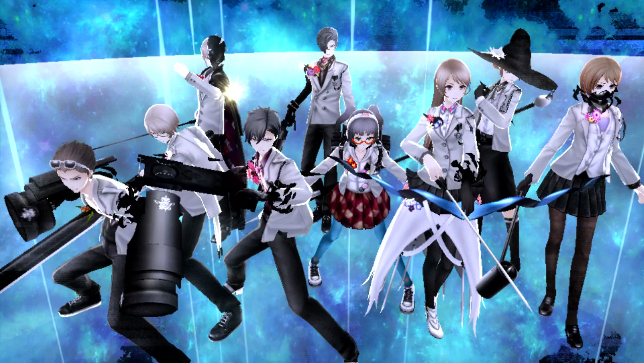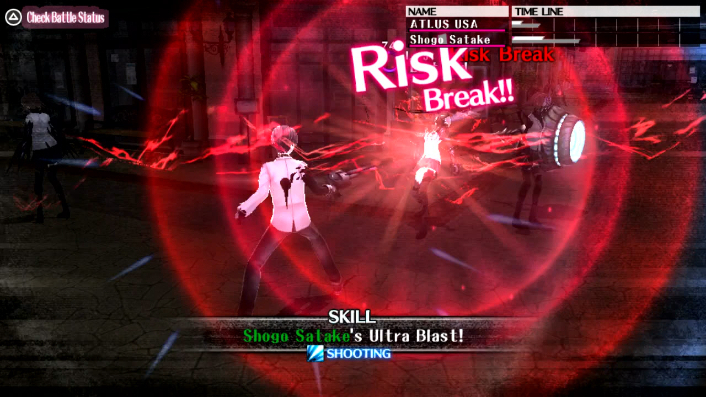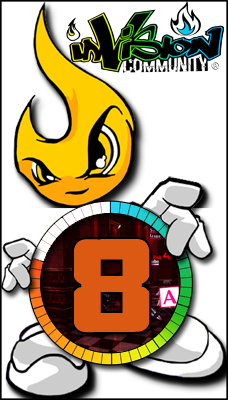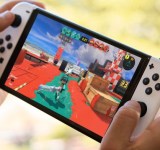The Caligula Effect is a Dungeon Crawling third person JRPG developed by Aquira and published by Atlas available for PlayStation vita. Featuring the same writer as the first three Persona games Tadashi Satomi it very much shows in the concept of the game which is reminiscent of the Persona games yet has its own flavour of originality.
The Game takes place in the world of Mobius, a constructed reality made by μ , a vocal program along with Aria which forces all there to repeat the first three years of an idyllic high school. The story starts with you, the protagonist, noticing glitches in the world. Being understandably freaked out this causes you to run out of the welcome ceremony and bump into a member of the Go-Home club, an organisation of fellow students that have noticed that there is something not quite right in this world. With the help of Aria and the Go home club you seek to exit Mobius against the Ostinato Musicians who are a group trying to keep perfect harmony to Mobius by preventing people from leaving. The game does a brilliant job of creating likable characters and a narrative which supports them as well as maintaining a very interesting core story thread as we slowly unwind it through not just the story but the individuals which are a part of it.

There are two main sides to the games gameplay combat and Japanese high school friend simulator. Combat occurs in the game by encountering an enemy wandering around the world which launches you into a real time turn based battle. The really interesting part of this comes in the chain effect in which you can organise when and how your team attacks the target allowing you to pull off some visually impressive and incredibly mechanically devastating combos. This 3D combat is very impressive and honestly was not something I was expecting to be as good as it was. This and with how the game allows you to set up these chains it is incredibly easy for you, the player, to have real control over the battlefield. The second part of the gameplay involves you talking to over five hundred NPCs to find out about them and complete quests given to you by them. These quests usually revolve around befriending people around there circle or talking to them with a specific stigma equip (the game’s version of armour and the like) which in turn rewards you with more stigma’s to use. This adds a massive portion to the game however personally I would have rather a hell of a lot less of this. It fits within the game and makes sense but spamming the conversation button gets annoying after a while and each interaction with each of the five hundred NPCs does not really feel meaningful and just part of the grind. As I said, I think it’s a good idea and a good mechanic overall as it really ties in with the games overall theme. But, if you’re a one-hundred percent completion whore in games this is going to be where you sink the majority of time within the game so good luck.

With all RPG’s there is a leveling system, however, Caligula’s is rather unique. In the same way as most games when you fight an enemy you defeat them granting you experience leveling your character making them stronger. But, when leveling you also gain skill points. Rather than these skill points being individual for each character, it is a pool they all draw on to buy skills making a very interesting set of decisions In what characters to spend these on. The game’s equipment also has a quite unique approach to what constitutes equipment. Instead of having the standard armour/weapon slots instead you have different types of stigmas which can be assigned to whoever you like. With equipment like “Misleading Mania” and “Heartless” it really fits in within the game and further solidifying the themes, the game introduces within the narrative making the equipment feel more original and to do with the world rather than the boring bog standard iron helm and sharp sword of plus five. This simplicity allows a player to get to grips with how to best achieve what they want without distracting too much from the more entertaining complicated and engaging combat mechanics the game offers.

The game visually is very reminiscent of the Persona games especially with its cut scene animations but, with its own slightly cleaner sharper aesthetic and with the game visually really standing out in its combat. The game keeps a great balance of clarity and stunning visuals when using skills which are especially present when you get a great chain going and really adds to the experience making the combat just that bit more enjoyable. The soundtrack suits the game well with its heavy Japanese influence and although it may not be my personal taste I can definitely appreciate it within the context and theme of the game.

Overall the game feels similar to another persona game but with its own original twist, the exciting story is matched by the exhilarating combat which is enhanced by its simplicity. The progression the game gives too is fairly simple allowing you to really concentrate on enjoying the experience rather than managing your invent which a lot of RPG’s have a habit of falling into. There are issues with the game, however, such as how the games NPC’s are pretty much the same but the characters which are not the NPC, your antagonists, allies and μ are great proving its quality rather than quantity. If you are a fan of JRPG’s with an action-packed combat system and very deep storyline which is not afraid to hit some of those darker and somewhat depressing places of the human psyche then this will be a brilliant game for you. Just glad I do not work for an educational facilities admin staff.









You must be logged in to post a comment.